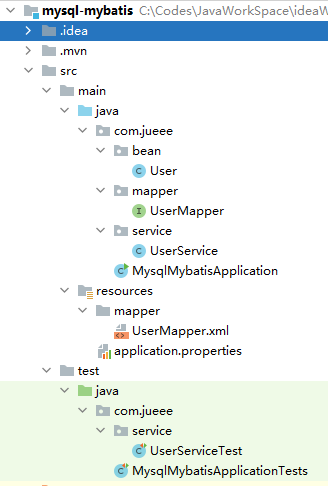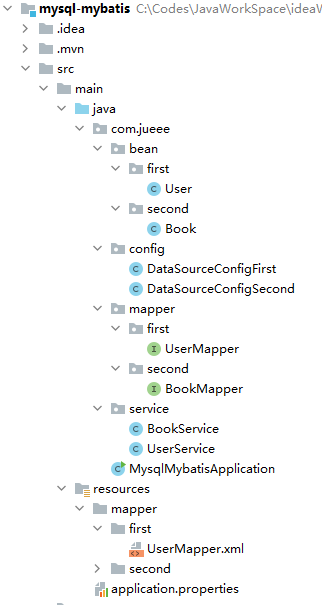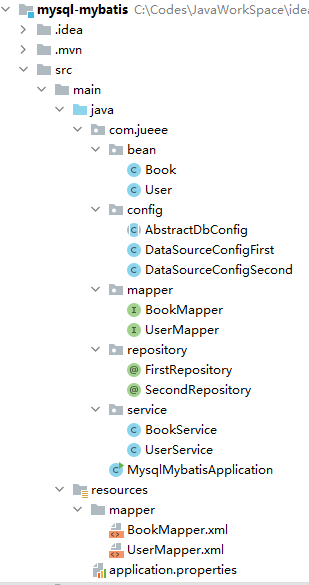SpringBoot 通过 Druid 集成 MyBatis 数据源
MyBatis 介绍
MyBatis 是一款优秀的持久层框架,它支持自定义 SQL、存储过程以及高级映射。MyBatis 免除了几乎所有的 JDBC 代码以及设置参数和获取结果集的工作。MyBatis 可以通过简单的 XML 或注解来配置和映射原始类型、接口和 Java POJO(Plain Old Java Objects,普通老式 Java 对象)为数据库中的记录。
maven 配置
<dependencies>
<dependency>
<groupId>org.mybatis.spring.boot</groupId>
<artifactId>mybatis-spring-boot-starter</artifactId>
<version>2.1.4</version>
</dependency>
<dependency>
<groupId>mysql</groupId>
<artifactId>mysql-connector-java</artifactId>
<scope>runtime</scope>
</dependency>
<dependency>
<groupId>com.alibaba</groupId>
<artifactId>druid-spring-boot-starter</artifactId>
<version>1.2.4</version>
</dependency>
<dependency>
<groupId>org.projectlombok</groupId>
<artifactId>lombok</artifactId>
<optional>true</optional>
</dependency>
<dependency>
<groupId>org.springframework.boot</groupId>
<artifactId>spring-boot-starter-test</artifactId>
<scope>test</scope>
</dependency>
</dependencies>配置单数据源
配置文件
spring.datasource.driverClassName=com.mysql.cj.jdbc.Driver spring.datasource.url=jdbc:mysql://localhost:3306/test?serverTimezone=UTC spring.datasource.username=xxx spring.datasource.password=xxx mybatis.mapper-locations=classpath:mapper/*Mapper.xml mybatis.type-aliases-package=com.jueee.beanBean
import lombok.Data; @Data public class User { private Long id; private String username; private String nickname; }Mapper
import com.jueee.bean.User; import org.springframework.stereotype.Repository; @Repository public interface UserMapper { User selectById(int id); }Mapper
<?xml version="1.0" encoding="UTF-8"?> <!DOCTYPE mapper PUBLIC "-//mybatis.org//DTD Mapper 3.0//EN" "http://mybatis.org/dtd/mybatis-3-mapper.dtd"> <mapper namespace="com.jueee.mapper.UserMapper"> <select id="selectById" resultType="com.jueee.bean.User"> select * from user where id = #{id} </select> </mapper>Service
import com.jueee.bean.User; import com.jueee.mapper.UserMapper; import org.springframework.beans.factory.annotation.Autowired; import org.springframework.stereotype.Service; @Service public class UserService { @Autowired private UserMapper userMapper; public User selectById(int id){ return userMapper.selectById(id); } }测试类
import com.jueee.bean.User; import lombok.extern.slf4j.Slf4j; import org.junit.jupiter.api.Test; import org.springframework.beans.factory.annotation.Autowired; import org.springframework.boot.test.context.SpringBootTest; @Slf4j @SpringBootTest public class UserServiceTest { @Autowired private UserService userService; @Test public void selectById(){ User user = userService.selectById(1); log.info(user.getNickname()); // 小章鱼 } }
项目结构

配置多数据源
注意点:
- @Primary 注解的使用
- 目录结构中,实体类目录建议根据多数据源的配置进行分层,因为在多数据源配置中存在相关配置
相关配置如下:
配置文件
spring.datasource.first.driverClassName=com.mysql.cj.jdbc.Driver spring.datasource.first.jdbc-url=jdbc:mysql://127.0.0.1:3306/vuedb?serverTimezone=UTC spring.datasource.first.username=xxx spring.datasource.first.password=xxx spring.datasource.second.driverClassName=com.mysql.cj.jdbc.Driver spring.datasource.second.jdbc-url=jdbc:mysql://127.0.0.1:3306/test?serverTimezone=UTC spring.datasource.second.username=xxx spring.datasource.second.password=xxx与单数据源配置
spring.datasource.second.url不同,多数据源时需配置spring.datasource.second.jdbc-url,否则会报错:jdbcUrl is required with driverClassNamespring.datasource.url 数据库的 JDBC URL。
spring.datasource.jdbc-url 用来重写自定义连接池
官方文档 的解释是:
因为连接池的实际类型没有被公开,所以在您的自定义数据源的元数据中没有生成密钥,而且在 IDE 中没有完成 (因为 DataSource 接口没有暴露属性)。
对应不同的数据源,,进行匹配
主数据源 primary 配置如下:
import org.apache.ibatis.session.SqlSessionFactory; import org.mybatis.spring.SqlSessionFactoryBean; import org.mybatis.spring.SqlSessionTemplate; import org.mybatis.spring.annotation.MapperScan; import org.springframework.beans.factory.annotation.Qualifier; import org.springframework.boot.context.properties.ConfigurationProperties; import org.springframework.boot.jdbc.DataSourceBuilder; import org.springframework.context.annotation.Bean; import org.springframework.context.annotation.Configuration; import org.springframework.context.annotation.Primary; import org.springframework.core.io.support.PathMatchingResourcePatternResolver; import javax.sql.DataSource; @Configuration @MapperScan(basePackages = "com.jueee.mapper.first", sqlSessionFactoryRef = "firstSqlSessionFactory") public class DataSourceConfigFirst { @Primary // 表示这个数据源是默认数据源 @Bean(name = "firstDataSource") @ConfigurationProperties(prefix = "spring.datasource.first") // 读取application.properties中的配置参数映射成为一个对象 public DataSource getDateSource1() { return DataSourceBuilder.create().build(); } @Primary // 表示这个数据源是默认数据源 @Bean(name = "firstSqlSessionFactory") public SqlSessionFactory firstSqlSessionFactory(@Qualifier("firstDataSource") DataSource datasource) // @Qualifier表示查找Spring容器中名字为firstDataSource的对象 throws Exception { SqlSessionFactoryBean bean = new SqlSessionFactoryBean(); bean.setDataSource(datasource); bean.setMapperLocations(new PathMatchingResourcePatternResolver().getResources("classpath*:mapper/first/*.xml")); // // 设置mybatis的xml所在位置 return bean.getObject(); } @Primary // 表示这个数据源是默认数据源 @Bean("firstSqlSessionTemplate") public SqlSessionTemplate firstSqlSessionTemplate( @Qualifier("firstSqlSessionFactory") SqlSessionFactory sessionFactory) { return new SqlSessionTemplate(sessionFactory); } }主数据源配置中,相对应的注入 bean 一定要加上注解 @Primary,否则报错!
第二数据源配置如下:
import org.apache.ibatis.session.SqlSessionFactory; import org.mybatis.spring.SqlSessionFactoryBean; import org.mybatis.spring.SqlSessionTemplate; import org.mybatis.spring.annotation.MapperScan; import org.springframework.beans.factory.annotation.Qualifier; import org.springframework.boot.context.properties.ConfigurationProperties; import org.springframework.boot.jdbc.DataSourceBuilder; import org.springframework.context.annotation.Bean; import org.springframework.context.annotation.Configuration; import org.springframework.context.annotation.Primary; import org.springframework.core.io.support.PathMatchingResourcePatternResolver; import javax.sql.DataSource; @Configuration @MapperScan(basePackages = "com.jueee.mapper.second", sqlSessionFactoryRef = "secondSqlSessionFactory") public class DataSourceConfigSecond { // 将这个对象放入Spring容器中 @Bean(name = "secondDataSource") @ConfigurationProperties(prefix = "spring.datasource.second") // 读取application.properties中的配置参数映射成为一个对象 public DataSource getDateSource1() { return DataSourceBuilder.create().build(); } @Bean(name = "secondSqlSessionFactory") public SqlSessionFactory secondSqlSessionFactory(@Qualifier("secondDataSource") DataSource datasource) // @Qualifier表示查找Spring容器中名字为secondDataSource的对象 throws Exception { SqlSessionFactoryBean bean = new SqlSessionFactoryBean(); bean.setDataSource(datasource); bean.setMapperLocations(new PathMatchingResourcePatternResolver().getResources("classpath*:mapper/second/*.xml")); // // 设置mybatis的xml所在位置 return bean.getObject(); } @Bean("secondSqlSessionTemplate") public SqlSessionTemplate secondSqlSessionTemplate( @Qualifier("secondSqlSessionFactory") SqlSessionFactory sessionFactory) { return new SqlSessionTemplate(sessionFactory); } }Bean
com.jueee.bean.first.User类:import lombok.Data; @Data public class User { private Long id; private String username; private String nickname; }com.jueee.bean.second.Book类:import lombok.Data; @Data public class Book { private Long id; private String author; private String description; private String title; }Mapper
com.jueee.first类:import com.jueee.bean.first.User; import org.springframework.stereotype.Repository; @Repository public interface UserMapper { User selectById(int id); }com.jueee.mapper.second类:import com.jueee.bean.second.Book; import org.springframework.stereotype.Repository; import java.util.List; @Repository public interface BookMapper { List<Book> selectAll(); }Mapper 对应的 xml 文件。
<?xml version="1.0" encoding="UTF-8"?> <!DOCTYPE mapper PUBLIC "-//mybatis.org//DTD Mapper 3.0//EN" "http://mybatis.org/dtd/mybatis-3-mapper.dtd"> <mapper namespace="com.jueee.mapper.first.UserMapper"> <select id="selectById" resultType="com.jueee.bean.first.User"> select * from user where id = #{id} </select> </mapper><?xml version="1.0" encoding="UTF-8"?> <!DOCTYPE mapper PUBLIC "-//mybatis.org//DTD Mapper 3.0//EN" "http://mybatis.org/dtd/mybatis-3-mapper.dtd"> <mapper namespace="com.jueee.mapper.second.BookMapper"> <resultMap id="BaseResultMap" type="com.jueee.bean.second.Book"> <result column="id" jdbcType="INTEGER" property="id" /> <result column="author" jdbcType="VARCHAR" property="author" /> <result column="description" jdbcType="VARCHAR" property="description" /> <result column="title" jdbcType="VARCHAR" property="title" /> </resultMap> <select id="selectAll" resultMap="BaseResultMap"> select * from book </select> </mapper>Service 和 Test 与单数据源一致,不再赘述。
项目结构

注解匹配多数据源
相关配置如下:
使用注解方式,需要引入 druid 包:
<dependency> <groupId>com.alibaba</groupId> <artifactId>druid-spring-boot-starter</artifactId> <version>1.2.4</version> </dependency>配置文件
spring.datasource.first.driverClassName=com.mysql.cj.jdbc.Driver spring.datasource.first.jdbc-url=jdbc:mysql://127.0.0.1:3306/vuedb?serverTimezone=UTC spring.datasource.first.username=xxx spring.datasource.first.password=xxx spring.datasource.second.driverClassName=com.mysql.cj.jdbc.Driver spring.datasource.second.jdbc-url=jdbc:mysql://127.0.0.1:3306/test?serverTimezone=UTC spring.datasource.second.username=xxx spring.datasource.second.password=xxx mybatis.mapper-location=classpath*:mapper/*.xml数据源通用方法 AbstractDatasource:
import com.alibaba.druid.pool.DruidDataSource; import org.apache.ibatis.session.SqlSessionFactory; import org.mybatis.spring.SqlSessionFactoryBean; import org.springframework.core.io.Resource; import org.springframework.core.io.support.PathMatchingResourcePatternResolver; import org.springframework.core.io.support.ResourcePatternResolver; import javax.sql.DataSource; public abstract class AbstractDbConfig { protected SqlSessionFactory sqlSessionFactory(DataSource dataSource, String mapperLocation) throws Exception { SqlSessionFactoryBean factoryBean = new SqlSessionFactoryBean(); factoryBean.setDataSource(dataSource); ResourcePatternResolver resourceResolver = new PathMatchingResourcePatternResolver(); Resource[] resource= resourceResolver.getResources(mapperLocation); factoryBean.setMapperLocations(resource); return factoryBean.getObject(); } protected DataSource dataSourceFactory(String driveClassName, String url, String userName, String password){ DruidDataSource datasource = new DruidDataSource(); datasource.setDriverClassName(driveClassName); datasource.setUrl(url); datasource.setUsername(userName); datasource.setPassword(password); datasource.setMaxActive(20); datasource.setInitialSize(20); return datasource; } }对应不同的数据源,进行匹配
import com.jueee.repository.FirstRepository; import org.mybatis.spring.SqlSessionTemplate; import org.mybatis.spring.annotation.MapperScan; import org.springframework.beans.factory.annotation.Qualifier; import org.springframework.beans.factory.annotation.Value; import org.springframework.context.annotation.Bean; import org.springframework.context.annotation.Configuration; import org.springframework.jdbc.datasource.DataSourceTransactionManager; import org.springframework.transaction.PlatformTransactionManager; import javax.sql.DataSource; @Configuration @MapperScan(basePackages = {"com.jueee"},annotationClass = FirstRepository.class, sqlSessionTemplateRef = "firstUserTemplate") public class DataSourceConfigFirst extends AbstractDbConfig { @Value("${spring.datasource.first.jdbc-url}") private String url; @Value("${spring.datasource.first.username}") private String userName; @Value("${spring.datasource.first.password}") private String password; @Value("${spring.datasource.first.driver-class-name}") private String driveClassName; @Value(value = "${mybatis.mapper-location}") private String mapperLocation; @Bean(name = "firstUser") public DataSource secondaryDataSource() { return dataSourceFactory(driveClassName, url, userName, password); } @Bean(name = "firstUserTemplate") public SqlSessionTemplate firstUserSqlTemplate() throws Exception { return new SqlSessionTemplate((sqlSessionFactory(secondaryDataSource(), mapperLocation))); } @Bean @Qualifier("firstUserTransaction") public PlatformTransactionManager firstUserTransaction() { return new DataSourceTransactionManager(secondaryDataSource()); } }第二数据源配置如下:
import com.jueee.repository.SecondRepository; import org.mybatis.spring.SqlSessionTemplate; import org.mybatis.spring.annotation.MapperScan; import org.springframework.beans.factory.annotation.Qualifier; import org.springframework.beans.factory.annotation.Value; import org.springframework.context.annotation.Bean; import org.springframework.context.annotation.Configuration; import org.springframework.jdbc.datasource.DataSourceTransactionManager; import org.springframework.transaction.PlatformTransactionManager; import javax.sql.DataSource; @Configuration @MapperScan(basePackages = {"com.jueee"},annotationClass = SecondRepository.class, sqlSessionTemplateRef = "secondUserTemplate") public class DataSourceConfigSecond extends AbstractDbConfig { @Value("${spring.datasource.second.jdbc-url}") private String url; @Value("${spring.datasource.second.username}") private String userName; @Value("${spring.datasource.second.password}") private String password; @Value("${spring.datasource.second.driver-class-name}") private String driveClassName; @Value(value = "${mybatis.mapper-location}") private String mapperLocation; @Bean(name = "secondUser") public DataSource secondaryDataSource() { return dataSourceFactory(driveClassName, url, userName, password); } @Bean(name = "secondUserTemplate") public SqlSessionTemplate secondUserSqlTemplate() throws Exception { return new SqlSessionTemplate((sqlSessionFactory(secondaryDataSource(), mapperLocation))); } @Bean @Qualifier("secondUserTransaction") public PlatformTransactionManager secondUserTransaction() { return new DataSourceTransactionManager(secondaryDataSource()); } }定义注解,分别作为不同数据库的表识。
import org.apache.ibatis.annotations.Mapper; import org.springframework.stereotype.Component; import java.lang.annotation.*; @Documented @Retention(RetentionPolicy.RUNTIME) @Target(ElementType.TYPE) @Component @Mapper public @interface FirstRepository { String value() default ""; }import org.apache.ibatis.annotations.Mapper; import org.springframework.stereotype.Component; import java.lang.annotation.*; @Documented @Retention(RetentionPolicy.RUNTIME) @Target(ElementType.TYPE) @Component @Mapper public @interface SecondRepository { String value() default ""; }Bean:
com.jueee.bean.User类:import lombok.Data; @Data public class User { private Long id; private String username; private String nickname; }com.jueee.bean.Book类:import lombok.Data; @Data public class Book { private Long id; private String author; private String description; private String title; }Mapper
com.jueee类:import com.jueee.bean.User; import com.jueee.repository.FirstRepository; @FirstRepository public interface UserMapper { User selectById(int id); }import com.jueee.bean.Book; import com.jueee.repository.SecondRepository; import java.util.List; @SecondRepository public interface BookMapper { List<Book> selectAll(); }Service 和 Test 与单数据源一致,不再赘述。
项目结构
